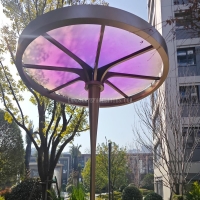Welcome to the website for landscape facilities products and knowledge.
How does the design of a landscape bar counter influence its ability to blend into natural surroundings?
The integration of a landscape bar counter into its natural surroundings represents a sophisticated exercise in environmental harmony and design intentionality. Unlike conventional bars that assert their presence, these structures employ several strategic design principles to become virtually indistinguishable from the landscape itself.
Material selection serves as the foundational element in this integration process. Designers increasingly utilize locally sourced stone, reclaimed timber, and textured composites that mirror the geological and botanical characteristics of the immediate environment. A bar counter crafted from indigenous slate or weathered teak doesn't just occupy space—it emerges from it, creating visual continuity that tricks the eye and soothes the perception.
The philosophy of biomimicry further enhances this blending effect. Counters that emulate the flowing lines of nearby topography, incorporate organic irregularities, or feature plant-integrated channels demonstrate how design can follow natural precedents rather than oppose them. These elements reject rigid geometry in favor of forms that appear shaped by natural forces rather than human intervention.
Strategic positioning and elevation management determine whether a structure floats above the landscape or grows from it. Counters built into existing slopes, wrapped around mature trees, or extending from rock formations utilize the site's natural features as structural partners. This approach minimizes earth disturbance while creating the illusion that the bar counter was always part of the environmental composition.
The critical role of transitional elements cannot be overstated. Green roofs planted with native vegetation, living walls that incorporate local flora, and concealed edges that allow ground cover to creep toward the structure effectively erase the hard line between built and natural environments. These biological bridges facilitate a gradual transition that makes the artificial element acceptable within the natural setting.
Advanced designers employ sensory integration techniques that extend beyond visual mimicry. The strategic use of water features that replicate natural sounds, surface temperatures that match surrounding stone, and even aromatic wood selections that release familiar scents all contribute to a multisensory experience of belonging.
Lighting design represents another crucial consideration. Counters utilizing shielded downward lighting that mimics moonlight, fiber optic elements that recreate starlight effects, or adjustable temperature LEDs that match the golden hour spectrum prevent light pollution while maintaining the natural evening ambiance. This careful illumination allows the structure to disappear into the darkness rather than disrupt it.
The most successful landscape bar counters achieve what designers term "ecological servitude"—they serve human function while submitting to environmental context. This approach transforms the bar from an object placed in nature to an organic extension of nature itself, demonstrating that human hospitality and wild landscapes need not exist in opposition but can instead achieve profound and beautiful synthesis.
Related search:

Recommendation
Metal frame with gradient color acrylic combined with high-end shading landscape facilities